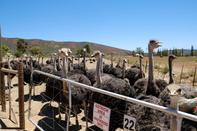
The South African Ostrich Business Chamber (SAOBC) and its sub-association, the National Ostrich Processors Association of South Africa (NOPSA), provide concrete benefits to its members.
These benefits serve to aid South African Ostrich Business Chamber (SAOBC) members in producing the highest quality products and ensuring that ostrich producers and processors participate in profitable and environmentally friendly farming practices. Members of the SAOBC have access to the research the association invests in to grow the ostrich industry.
Members receive regular updates on the process of ongoing research as well as access to the association to commission research on particular problems that face the ostrich industry, to yield information for members that aid in diseases control, beneficial and sustainable farming practices, and efficient processing and packaging methods to maximise members, producers and processors’ profits.
Members of NOPSA, and in turn SAOBC, are invited to participate in seminars, get-togethers and study groups to meet and share solutions, ask questions and support each other with information.
The South African Ostrich Business Chamber is able to provide its members with a standard that matches both the local and international market with regard to ostrich farming, processing and packaging in ostrich abattoirs and overall final ostrich products created. Therefore continuously producing high quality products on a continuous basis which benefits the whole ostrich industry.
SAOBC allows members to participate in projects that raise awareness of the ethical practices in ostrich leather production and encourage young designers with an interest in ostrich leather to practice sustainable promotion of the raw material. The SAOBC also provides structure to the ostrich industry for lobbying and communication about legislation and policies.
 South Africa was the first country in the world where ostrich farming started on a commercial basis, in the mid-1820s feathers were harveste...
South Africa was the first country in the world where ostrich farming started on a commercial basis, in the mid-1820s feathers were harveste...